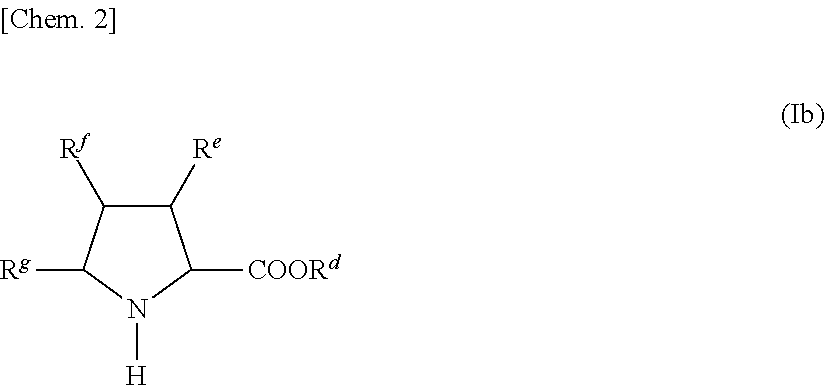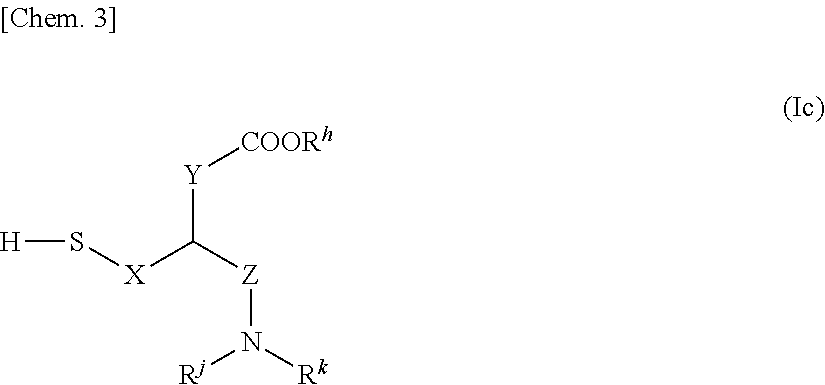Rubber composition and method for producing rubber composition
a technology of composition and rubber, applied in the field of rubber composition, can solve the problem that the effect of amino acid as an improving agent for vulcanization acceleration efficiency cannot be sufficiently provided, and achieve the effect of improving the low-heat generation property of tires and accelerating the vulcanization ra
- Summary
- Abstract
- Description
- Claims
- Application Information
AI Technical Summary
Benefits of technology
Problems solved by technology
Method used
Image
Examples
examples
[0110]The present invention is described in more detail with reference to the following Examples; however, the present invention is not limited at all by the following Examples.
[Evaluation Methods]
[0111]Using a rotorless rheometer, RLR-3 Model manufactured by Toyo Seiki Seisaku-sho, Ltd., a sample was given a constant amplitude vibration, and the time-dependent variation of the torque having been generated through the deformation of the sample and transferred onto a dice was automatically recorded. The time (min) corresponding to t0.9=90% vulcanization time (min)={(maximum torque−minimum torque)×0.9+minimum torque} was indexed to give the index of the vulcanization rate. The samples having a smaller index value have a higher vulcanization accelerating effect.
[0112]Using a viscoelasticity measuring device (manufactured by Rheometric Scientific, Inc.), tan δ of a sample was measured at a temperature of 60° C., at a dynamic strain of 5% and at a frequency of 15 Hz. Based on the recipro...
examples 1 to 7
, Comparative Examples 1, 2
[0113]In the first kneading stage of kneading the rubber composition of Examples 1 to 7, the rubber component (A), all of the inorganic filler (C), the silane coupling agent (D), carbon black, aromatic oil, stearic acid and antioxidant 6PPD were kneaded in a Banbury mixer. Next, in the final kneading stage, the additives shown in Table 1 were added thereto and kneaded, and the maximum temperature of the rubber composition in the final kneading stage was controlled to be 110° C.
[0114]The vulcanization rate of the vulcanized rubber compositions obtained from these 9 types of rubber compositions was evaluated. The results are shown in Table 1.
[Table 1]
[0115]
TABLE 1ComparativeExampleExampleComponents (part by mass)123456712SBR *11001001001001005050100100Natural Rubber *200000505000Carbon Black-1 N220 *3101010101010101010Silica *4505050505050505050Silane Coupling Agent Si75 *5555555555Aromatic Oil303030303030303030Stearic Acid222222222Zinc Flower2.52.52.52.52.5...
examples 8 to 18
, Comparative Examples 3, 4, 5
[0116]In the first kneading stage of kneading the rubber composition of Examples 8 to 18, the rubber component (A), all of the inorganic filler (C), the silane coupling agent (D), carbon black, aromatic oil, stearic acid and antioxidant 6PPD were kneaded in a Banbury mixer, and after 60 seconds, different types of amino acid derivatives (B) represented by the above-mentioned general formula (Ic) were added thereto and further kneaded. The maximum temperature of the rubber composition in the first kneading stage was controlled to be 150° C. Next, in the final kneading stage, the additives shown in Table 2 were added thereto and kneaded, and the maximum temperature of the rubber composition in the final kneading stage was controlled to be 110° C. In Comparative Examples 3 and 4, the components were kneaded in the same manner as in Examples 1 to 11 except that the amino acid derivative (B) was not added in the first kneading stage. In Comparative Example 5...
PUM
| Property | Measurement | Unit |
|---|---|---|
| BET specific surface area | aaaaa | aaaaa |
| BET specific surface area | aaaaa | aaaaa |
| BET specific surface area | aaaaa | aaaaa |
Abstract
Description
Claims
Application Information
 Login to View More
Login to View More - R&D
- Intellectual Property
- Life Sciences
- Materials
- Tech Scout
- Unparalleled Data Quality
- Higher Quality Content
- 60% Fewer Hallucinations
Browse by: Latest US Patents, China's latest patents, Technical Efficacy Thesaurus, Application Domain, Technology Topic, Popular Technical Reports.
© 2025 PatSnap. All rights reserved.Legal|Privacy policy|Modern Slavery Act Transparency Statement|Sitemap|About US| Contact US: help@patsnap.com



